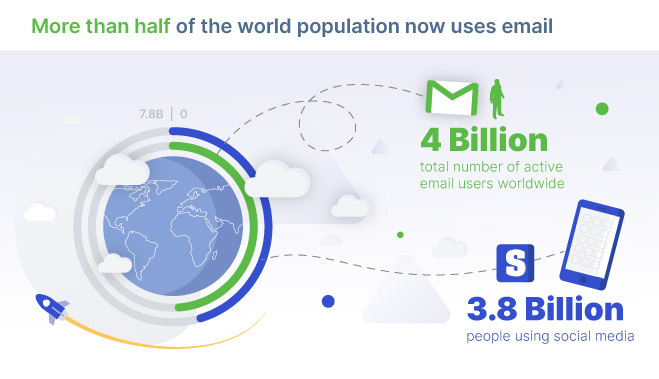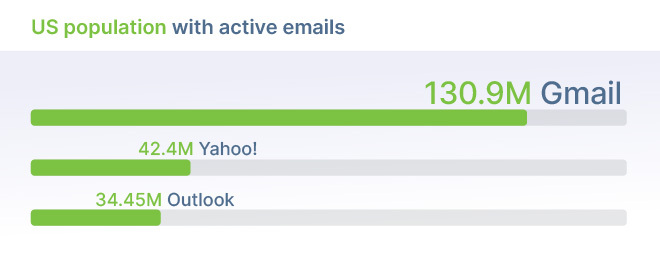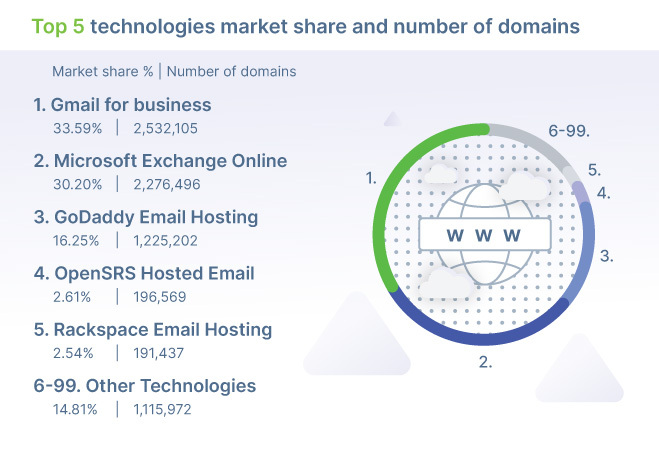Email Usage Statistics in 2021

Do you remember a time before email?
If you were born after 1995, probably not.
Today, email is a ubiquitous form of communication in both the personal and professional world. Combined with the amount of personal information available online, it allows you to reach anyone you want – even if you’ve never met them in person.
This is extremely powerful for those in the marketing world. With email, it becomes possible to build a business and network with industry influencers. This is especially true with the advent of cold email outreach software, which allows you to do so at scale.
Even with the rise in social media usage, email still remains king. And we’ve got the numbers to prove it.
These recent email usage statistics show you why email is still the best way to build a personal connection with someone over the internet. Alternative channels, such as social media, are great for making initial contact or getting on someone’s radar, but email is where you can build deep relationships – especially in the professional world.
How has email usage changed over the last 5 years?
Before jumping into 2021 email usage statistics, it’s important to know how email usage has changed over the past few years. New technologies have enabled marketers to take more advantage of email than ever before.
Not too long ago, sales people, PR reps, and link building experts would send emails to each prospect, one at a time.
Now, with the help of email outreach software, the process of sending out tons of emails has become much more efficient.
By allowing these professionals to leverage the power of email templates, they can focus their efforts on closing deals with prospects that do respond to their outreach.
While new technology is one way email has changed over the past few years, one of the more notable trends is that email is actually continuing to grow. According to Statista, email usage is predicted to grow by 2 to 3% each year until 2024.
More importantly, with the number of emails being sent and received continuing to rise, more and more emails are being ignored. This means that businesses relying on email outreach as a method of driving results are starting to put more effort into personalizing their emails and warming up their prospects before reaching out.
10 email usage statistics you need to know about in 2021
If you’re using email outreach as a method of growing your business, there are a few critical stats you need to know in order to make the most of your efforts.
Here are 10 email usage statistics and trends to help you improve your outreach strategy.
1. There are over 4 billion people using email (source)
More than half of the world population now uses email. According to previous forecast data from Radicati and the projected growth rate of email from Statista, we estimate that the total number of active email users worldwide is over 4 billion.
This number represents accounts that have been used over the past three months, so it’s likely that there are many more email accounts that exist that aren’t being actively used.
For comparison sake, there are 3.8 billion people using social media.

While social media is quickly catching up, there are still far more email accounts.
This may mean that social media should be leveraged as an additional touch point for your outreach efforts to improve email response rates. This is an effective way to get on the radar of your prospects so your email has a familiar name once it hits their inbox.
2. Over 300 billion emails are sent each day (source)
With more and more people using email, it only makes sense that the number of emails being sent would increase as well.
In 2019, around 293 billion emails were being sent each day. Today, that number is over 300 billion. This includes both business and personal emails. This amounts to over 3.5 million emails being sent every second.
By 2023, it’s expected that this number will be closer to 350 billion as email continues to grow on a consistent basis.
3. Email users have an average of 1.75 email accounts (source)
With the use of email in the workplace, it makes sense that many of us would have more than one email address – to separate our work emails from personal ones.
With this in mind, how many email addresses does the average person have?
According to Radicati, the answer is 1.75.
While the data shows that a user has an average of two email addresses, these are median results.
If we take the averages from the equation, it’s likely that a small percentage of users have a large number of email addresses. Freelance workers, for example, might have a different email address for each client they work with.
With this type of work on the rise, it’s likely that the number of email addresses per user will continue to increase as a result.
Finally, as well as separating work and personal emails, people are signing up for additional email addresses as a way to filter out spam.
4. On average, 127 business emails sent and received per day per user (source)
According to recent data from Radicati, the average number of business emails sent and received per day per user in 2019 was 126.
When looking at the trends in their report, we estimate that this number has now reached 127 per day per user.
Of the 127 emails per day, historic data lets us assume that the changes in business email usage are broken down as follows:
- 98 emails received.
- 78 of these are legitimate.
- 20 of these are spam.
- 29 emails sent.

5. Overall, Gmail dominates the market with 45% market share and 1.8 billion users worldwide (source)
With over 1.8 billion users worldwide, Gmail clearly dominates the email market with 45% market share.
This far outpaces other providers such as Outlook and Yahoo! who have 400 million and 225 million users, respectively.
If we look at only the United States, Gmail wins by even a larger margin.
85% of the US population are active email users – that’s roughly 246 million users. Gmail accounts for 130.9 million of these, which means they have 53% market share in the US.
The only difference here is that in the US, Yahoo! is winning against Outlook. Yahoo! has 42.4 million users compared to Outlook’s 34.45 million.

With this in mind, when sending emails out, you might want to consider sending from a Gmail account of your own. This will allow you to customize your information and profile picture, which can improve your open rates.
See how it stands out more among the sea of emails?
6. Gmail and Outlook own the business world with a combined 63% market share (source)
When looking at the general population, Gmail is clearly the dominant email provider. However, if we dive into the world of business, things look a bit different.
When it comes to business email accounts, Gmail and Outlook are neck at neck with 34% and 30% market share, respectively. Gmail provides email hosting for more than 2.5 million domains, and outlook provides this for over 2.7 million domains.
This results in a combined market share of just over 63%.
In third place is GoDaddy’s email hosting service, which has a market share of just over 16% and services more than 1.2 million domains.

This means that, when it comes to conducting email outreach campaigns, both are good choices if you plan on customizing your information and profile picture, as these can help improve open rates.
Because of the slight lead in market share, Gmail has a small advantage here.
7. More than half of all emails are spam (source)
Back in 2009, 94% of all emails were spam.
While these numbers are significantly lower today, spam emails still make up an estimated 53% of all emails sent every day.
Because we know that 300 billion emails are sent every day, we can easily answer this question – How many spam emails are sent per day?
The answer is that out of the 300 billion emails sent every day, we can estimate that more than 159 billion spam emails are sent each day.
However, different sources have different answers to this question, making it a bit unclear.
Some studies indicate that the number of spam emails may be as high as 84%!
Other sources, like Spam Laws – a commonly referenced source for spam statistics – estimate that global spam volume is closer to 45%, which would indicate that 135 billion spam emails are sent per day.
On their site, however, they propose that the number of spam emails sent per day is closer to 14.5 billion.
This 14.5 billion number is definitely not 45% of our 300 billion emails per day number, which made me think that the data may be outdated.
When looking at the page through the Wayback Machine, a tool that shows historic changes to pages on the internet, we can see that this data hasn’t been updated since being published in 2007.
Because of this, we can consider that the 45% number is outdated.
Whatever the case, with technology enabling people to send emails at greater volume, it seems safe to say that more than half of emails sent today are spam.
8. 46% of all email opens are on a mobile device (source)
According to data from Litmus, 46% of all email opens are on a mobile device, making it the most popular environment for reaching emails.
With mobile devices making up a majority of internet traffic, this isn’t surprising.
What is surprising, however, is that the reading environment of emails varies depending on the industry.
According to Acoustic’s 2019 Marketing Benchmark Report, mobile open rates can be as high as 52.9% for the Automotive industry, and as low as 18.0% for Insurance.
The key takeaway here is that, regardless of your industry, it’s likely that the majority of people reading your emails are doing so on mobile devices.
Because of this, make sure your emails are easy to read and respond to from a smartphone or tablet.
9. 82% of workers check email outside of normal business hours (source)
Possibly due to the fact that our world is becoming increasingly connected due to the adoption of mobile devices, four out of five workers admit to checking their work email outside of business hours.
Another interesting takeaway from this data is that nearly half of all workers say they check their email every few hours. This remains true even if they aren’t working.
When conducting an email outreach campaign, it’s common practice to send emails during morning work hours to try and reach people while they’re in their inbox.
With workers checking their emails frequently in and outside of work hours, it might be worth experimenting with not-so-common timing for your next outreach campaign.
10. 91.5% of outreach emails are ignored (source)
According to a study from Backlinko, only 8.5% of emails receive a response.
This is very similar to what other case studies, like this one from the Moz blog, have previously found.
It’s no surprise that the vast majority of outreach emails are completely ignored. After all, generic outreach emails like this one are extremely common:
Fortunately, there are a number of things you can do to improve your chances of getting a response according to the Backlinko study:
- Send a follow up – Sending a single follow-up email can double your response rate.
- Use longer subject lines – Emails with long subject lines have a 24.6% higher response rate.
- Personalize your email body and subject line – Personalized subject lines can increase your response rate by up to 30.5%. Personalizing the body of the email can increase it by 32.7%. Together, these can significantly improve your outreach campaign’s performance.
- Include social media profiles in your signature – Including a link to your Twitter profile can increase your response rate by 8.2%, LinkedIn can increase it by 11.5%, and Instagram can increase it by 23.4%.
- Use outreach software – Email outreach software can help you systemize your outreach process. Not only does it help you scale and automate your outreach, but it also helps you avoid silly mistakes like using the wrong name, including the wrong website URL, etc. Good software will help you take full advantage of the above suggestions.
Conclusion
Now that we’ve covered the email usage statistics, here are some important takeaways:
- More emails are being sent than ever before.
- Gmail is the dominant email provider..
- The majority of emails are read on mobile devices.
- More than half of emails are spam.
- Most outreach emails are ignored.
With these statistics in mind, you can make more informed decisions about how to conduct your next email outreach campaign.
What was your biggest takeaway from the above statistics? Let me know in the comments!
